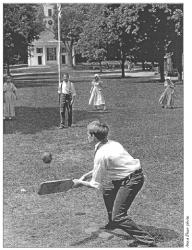All in a Day’s Fun

It's a hit!
Discovering Colonial History Through Play at Old Sturbridge Village
Published in Bay State Parent Magazine
“Let’s Play Ball!”
Though you may have recently heard it at your child’s little league game, those familiar words have actually been ringing down through the centuries. In fact, Henry Wadsworth Longfellow wrote in 1824, “…there is nothing now heard of in our leisure hours but ball, ball, ball…”
At Old Sturbridge Village in Sturbridge, Massachusetts, there’s lots of “ball, ball, ball”… being played this summer, not only for leisure, but also for learning. 19th-century-style “Base Ball” is a way to teach about life in the 1800s to any kid willing to step up to the plate.
“Play is a wonderful way to start kids learning about history,” says Devon Kurtz, Coordinator of Youth and Family Programs at Old Sturbridge Village. “We want to show that play and work in a lot of ways was linked together in the 1800s. People put just as much energy in their play as in their work.”
I have to admit that when I imagine life in Colonial New England, baseball isn’t the first thing that comes to my mind. Milking the cows is right up there, next to mending clothes and boiling turnips. Did you know that the average family in the 1830s had six children? As a mom of four, that would start my head spinning and my hands weaving.
But life then, as now, wasn’t all about work. And while Old Sturbridge Village traditionally has done an excellent job bringing everyday Colonial tasks to life through interpretative teaching, in the past few years they have begun to emphasize, well… fun.
“We want to provides lots of opportunities for children and parents and grandparents to all play together,” says Devon.
And they do. Whether it’s Trundling Hoops, Whoop! (Hide and Seek), Battledorre (badminton) or a massive French and English (Tug of War) on the green, kids and parents can be seen having fun in lots of nooks and crannies around the Common.
“People of different ages have different learning styles,” says Susie Bonta, Public Relations Manager. “Young kids learn by doing. That’s an area we’ve expanded upon. Some examples are KidStory (an indoor hands-on interactive play area for ages 3-10), the Small House assembly, the water pump, and the Base Ball games.”
I found that Old Sturbridge Village was not only a fun place for my kids, and also was an easy place for my husband and I to relax and enjoy ourselves. I met other parents who had the same response.
Jeanne is a mom of four girls, aged 8, 6, and 2-tyear-old twins. “I love the open area where they can run around and I can sill keep an eye on them,” she says. “This is a place I’ve come several times. There’s so much to see. And I can manage it.”
“We love it,” says Jean Marie and Michael of Westford. “The kids love being able to play as well as help with the farm chores. We like that. It really brings history alive for them. And they feel like they can explore.”
After morning activities and a picnic lunch, we headed to the green for…what else? Base Ball! This was the highlight of the day for my kids. Turns out it was a highlight for a lot of other kids as well.
If you go to Old Sturbridge Village to play Base Ball, remember this one thing… it is NOTHING like modern-day baseball. In fact, Devon is quick to tell the kids, “Everything you know about modern baseball today, FORGET!” He then begins to tell the large group of attentive kids the rules of the game. While he’s got everyone’s rapt attention, he takes the opportunity to weave in some interesting history, too.
The first thing I noticed was the equipment, or lack thereof. Instead of a bat, we used an axe handle (without the blade). The ball was soft, with a rubber center and wrapped with yarn and thread. Bases were marked with stakes. There were no baselines; therefore, no foul balls. Any contact made with the bat to ball was considered fair (Kids LOVE that rule!).
We learned good sportsmanship (“No spitting, no swearing, no stealing, and no sliding”), and how to properly express our jubilation (“Capital! Well Struck!”) or disappointment (“Thunderation!” “Fiddlesticks!” “Oh the Dickens!”). There were lots of other rules, but the big one to remember (which most kids forgot) was that the bases are run clockwise, which means that first base was left of the batter, where modern-day third base is.
The other rule that was a big “hit” was this: To get someone out, you had to touch them with the ball, which meant you could tag them or “soak” them by hitting them with the ball.
It was a great game. At least half the kids at bat ran to the wrong base, doing what came as, well, you might say, “first” nature. And, two of my kids scored a run!
All in all, our day at Sturbridge Village was a lot of fun for all our kids, from 3 ½ year-old Caleb to our teenager Jacob. My husband and I had a “Capital” time, too. If you haven’t been to Old Sturbridge Village recently, it’s worth a trip, because, now, more than ever, it’s a kid-friendly place where learning about Colonial life is a ball.
 My professional experience includes leading the creative efforts of three companies I have co-owned. I'm a seasoned copywriter/creative director, award-winning journalist, avid runner, and mom of four. Got a story idea you'd like to share? Email me at treske@nowspeed.com. You can also find me on Twitter: @trishreske, LinkedIn and Facebook.
My professional experience includes leading the creative efforts of three companies I have co-owned. I'm a seasoned copywriter/creative director, award-winning journalist, avid runner, and mom of four. Got a story idea you'd like to share? Email me at treske@nowspeed.com. You can also find me on Twitter: @trishreske, LinkedIn and Facebook.